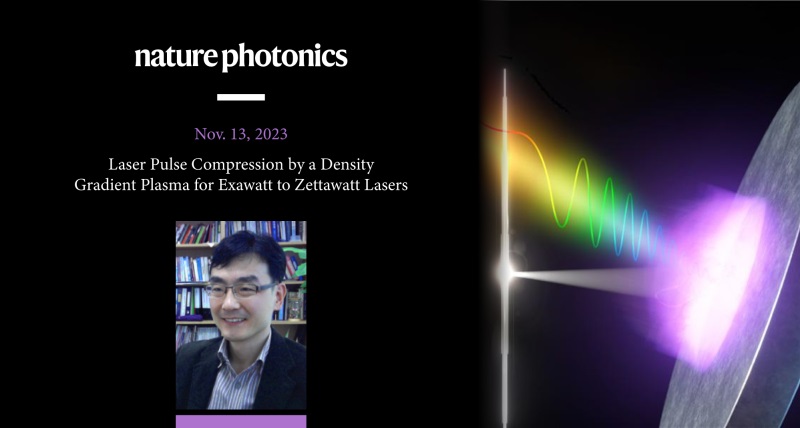Nov 22, 2023
JooHyeon Heo
A team of international researchers has made a significant breakthrough in laser technology, unveiling a novel method for compressing laser pulses to ultrahigh powers. The groundbreaking study, led by Professor Min Sup Hur from UNIST’s Department of Physics, Professor Hyong Suk from GIST, and Professor Dino A. Jaroszynski from the University of Strathclyde presents a new approach based on the spatially varying dispersion of inhomogeneous plasma.
Traditionally, laser pulse compression has relied on solid-state gratings or chirped mirrors. However, this innovative technique exploits the density ramp of an over-dense plasma slab to achieve pulse compression. As the density of the plasma increases longitudinally, different frequencies of photons within the laser pulse penetrate the plasma region to varying depths. This selective penetration results in pulse compression, similar to the mechanism of a chirped mirror.
The team conducted proof-of-principle simulations using particle-in-cell simulation codes, which demonstrated the compression of a 2.35 ps laser pulse to an astonishingly short duration of 10.3 fs. This compression ratio of 225 opens up new possibilities for reaching exawatt or zettawatt peak powers, as plasma is more robust and resistant to damage at high intensities compared to conventional solid-state gratings.
“This study presents a way to overcome the limitations of previous laser compression techniques and has far-reaching implications for various fields, including industrial and energy research, semiconductor lithography, laser fusion, and state-of-the-art astrophysics,” emphasized Professor Min Sup Hur of UNIST.
The Chirped Pulse Amplification method (CPA), which won the 2018 Nobel Prize in Physics, revolutionized laser technology and expanded its applications across multiple domains. However, the scientific community has been eagerly seeking methods to achieve even higher laser intensities. The newly proposed approach, utilizing inhomogeneous plasma, represents a significant step towards fulfilling this demand.
Plasma, a gaseous state separated into electrons and ions at high temperatures, offers a unique advantage over traditional diffraction mirrors. Unlike mirrors, plasma is not prone to damage, rendering it an excellent material for laser pulse compression. By exploiting this property, the research team envisions the use of plasma to generate lasers with intensities exceeding exawatt levels.
“Plasma can act as a highly effective alternative to conventional diffraction mirrors, compensating for the limitations of existing CPA technology,” explained Professor Hyong Suk from GIST. “With just a few centimeters of plasma, we can achieve ultrahigh-power lasers above the exawatt threshold.”
The implications of this breakthrough extend beyond laser technology. Ultrahigh-power lasers have emerged as vital tools for investigating fundamental questions related to space, matter, and the properties of space-time, as highlighted by Professor Dino A. Jaroszynski of the University of Strathclyde.
This groundbreaking research paves the way for a new era of ultrahigh-power lasers, offering unprecedented possibilities for scientific exploration, energy research, and industrial applications. The team’s findings promise to accelerate advancements in theoretical physics and astrophysics, while also serving as a cornerstone in the quest to address the pressing energy challenges facing humanity.
The findings of this research have been published in the online version of Nature Photonics on November 13, 2023. The study received support from the Ministry of Science and ICT/Korea Research Foundation, the Industrial Innovation Talent Growth Support Project of the UNIST Semiconductor Graduate School, and the UKRI/UK Science and Engineering Research Committee.
Journal Reference
Min Sup Hur, Bernhard Ersfeld, Hyojeong Lee, et al., “Laser pulse compression by a density gradient plasma for exawatt to zettawatt lasers,” Nat. Photon., (2023).
Abstract
We propose a new method of compressing laser pulses to ultrahigh powers based on spatially varying dispersion of an inhomogeneous plasma. Here, compression is achieved when a long, negatively frequency-chirped laser pulse reflects off the density ramp of an over-dense plasma slab. As the density increases longitudinally, high-frequency photons at the leading part of the laser pulse penetrate more deeply into the plasma region than lower-frequency photons, resulting in pulse compression in a similar way to that by a chirped mirror. Proof-of-principle simulations performed using particle-in-cell simulation codes predict compression of a 2.35 ps laser pulse to 10.3 fs—a ratio of 225. As plasma is robust and resistant to damage at high intensities—unlike solid-state gratings commonly used in chirped-pulse amplification—the method could be used as a compressor to reach exawatt or zettawatt peak powers.
https://www.nature.com/articles/s41566-023-01321-x





